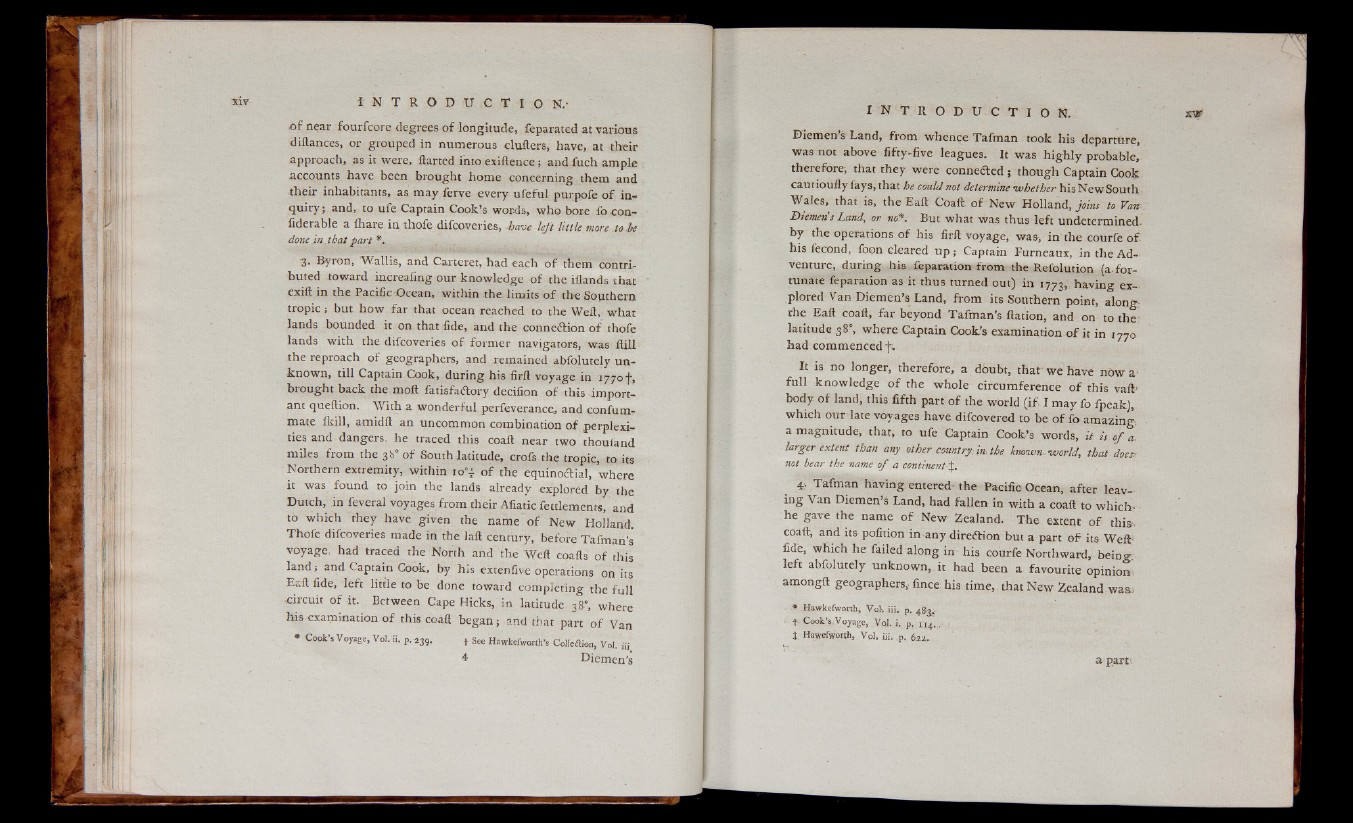
o f near fourfcore degrees o f longitude, feparated at various
diilances, or grouped in numerous clufters, have, at their
approach, as it were, ftarted into exiftence ; and.fuch ample
accounts have been brought home concerning them and
their inhabitants, as may ferve every ufeful purpofe of inquiry
; and, to ufe Captain Cook’s words, who bore fo con-
fiderable a ihare in thofe difcoveries, have left little mare to .be
done in,that fart *.
3- Byron, Wallis, and Carteret, had each of them contributed
toward increafing our knowledge of the iflands that
exift in the Pacific Ocean, within the limits o f the Southern
tropic; but how far that ocean reached to the Weft, what
lands bounded it on that fide, and the connection of thofe
lands with the difcoveries of former navigators, was ftill
the reproach of geographers, and remained abfolutely unknown,
till Captain Cook, during his firft voyage in 1770 t,
brought hack the moll fatisfaftory decifion o f this important
queftion. With a wonderful perfeverance, and confum-
mate ikill, amidft an uncommon combination o f perplexities
and dangers, he traced this coaft near two thouiand
miles from the 3b0 of South latitude, crofs the tropic, to its
Northern extremity, within 10”; o f the equinoctial, where
it was found to join the lands already explored by the
Dutch, in feveral voyages from their Afiatic fettlements, and
to which rhey have given the name of New Holland.
Thofe difcoveries made in the laft century, before Tafman’s
voyage, had traced the North and the Weft coafts o f this
land; and Captain Cook, by his extenfive operations on its
Eaft fide, left little to be done toward completing the full
circuit of it. Between Cape Hicks, in latitude 38*, where
his examination of this coaft began; and that part of Van
* Cook’s Voyage, Vol. ii. p.^39. t See Hawkdworth’« C o lle to n , Vol. ¡¡;
4 Diemen’s
Diemen s Land, from whence Tafman took his departure,
was not above fifty-five leagues. It was highly probable,
therefore; that they were conne&ed; though Captain Cook
cautioufly lays, that he could not determine -whether his New South
Wales, that is, the Eaft Coaft of New Holland, joins to Van
Diemen s Land, or no*. But what was thus left undetermined,
by the operations of his firft voyage, was, in the courfe of.
his fecond, foon cleared u p ; Captain Purneaux, in the Adventure,
during his feparation from the Refolution (a fortúnate
feparation as it thus turned out) in 17 7 3, having explored
Van Diemen’s Land, from its Southern point, along;
the Eaft coaft, far beyond Tafman’s ftation, and on to the
latitude 38°, where Captain Cook’s examination o f it in 1770
had commenced f;
It is no longer, therefore, a doubt, that-we have now a-
full knowledge of the whole circumference of this vaif
body of land, this fifth part o f the world ( if I may fo fpeak],
which our late voyages have difcovered to be of fo amazing,
a magnitude, that, to ufe Captain Cook’s words, it is of a.
larger extent than any other country: in. the known -world, that does)
not bear the name of a continent s.
4;. Tafman having entered-the Pacific Ocean, after leaving
Van Diemen’s Land, had fallen in with a coaft to which*
he gave the name o f New Zealand. The extent of this,
coaft, and its pofition in any direction but a part o f its Weft;
fide, which he failed along in his courfe Northward, , being;
left abfolutely unknown,, it had been a favourite opinion,
amongft geographers, fince his time, that New Zealand was,
* Hawkefworth, Vok ¡ii. p . 4 8 3 ,.
■ f . Cook’s.Voyage, VqI. i. p, 114...
J Hawefworth, Vol. iij. p. (,21,
a part